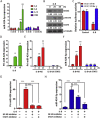IL-8 induces miR-424-5p expression and modulates SOCS2/STAT5 signaling pathway in oral squamous cell carcinoma
- PMID: 27038552
- PMCID: PMC5423170
- DOI: 10.1016/j.molonc.2016.03.001
IL-8 induces miR-424-5p expression and modulates SOCS2/STAT5 signaling pathway in oral squamous cell carcinoma
Abstract
Suppressor of cytokine signaling (SOCS) proteins are negative feedback regulators of the Janus kinase/signal transducer and activator of transcription (JAK/STAT) pathway. Dysregulation of SOCS protein expression in cancers can be one of the mechanisms that maintain STAT activation, but this mechanism is still poorly understood in oral squamous cell carcinoma (OSCC). Here, we report that SOCS2 protein is significantly downregulated in OSCC patients and its levels are inversely correlated with miR-424-5p expression. We identified the SOCS2 protein, which modulates STAT5 activity, as a direct target of miR-424-5p. The miR-424-5p-induced STAT5 phosphorylation, matrix metalloproteinases (MMPs) expression, and cell migration and invasion were blocked by SOCS2 restoration, suggesting that miR-424-5p exhibits its oncogenic activity through negatively regulating SOCS2 levels. Furthermore, miR-424-5p expression could be induced by the cytokine IL-8 primarily through enhancing STAT5 transcriptional activity rather than NF-κB signaling. Antagomir-mediated inactivation of miR-424-5p prevented the IL-8-induced cell migration and invasion, indicating that miR-424-5p is required for IL-8-induced cellular invasiveness. Taken together, these data indicate that STAT5-dependent expression of miR-424-5p plays an important role in mediating IL-8/STAT5/SOCS2 feedback loop, and scavenging miR-424-5p function using antagomir may have therapeutic potential for the treatment of OSCC.
Keywords: IL-8; Invasion; Oral squamous cell carcinoma; SOCS2; microRNA.
Copyright © 2016 The Authors. Published by Elsevier B.V. All rights reserved.
Figures






Similar articles
-
miRNA-491-5p and GIT1 serve as modulators and biomarkers for oral squamous cell carcinoma invasion and metastasis.Cancer Res. 2014 Feb 1;74(3):751-64. doi: 10.1158/0008-5472.CAN-13-1297. Epub 2013 Dec 12. Cancer Res. 2014. PMID: 24335959
-
miR-654-5p Targets GRAP to Promote Proliferation, Metastasis, and Chemoresistance of Oral Squamous Cell Carcinoma Through Ras/MAPK Signaling.DNA Cell Biol. 2018 Apr;37(4):381-388. doi: 10.1089/dna.2017.4095. Epub 2018 Jan 24. DNA Cell Biol. 2018. PMID: 29364705
-
LncRNA WDFY3-AS2 suppresses proliferation and invasion in oesophageal squamous cell carcinoma by regulating miR-2355-5p/SOCS2 axis.J Cell Mol Med. 2020 Jul;24(14):8206-8220. doi: 10.1111/jcmm.15488. Epub 2020 Jun 14. J Cell Mol Med. 2020. PMID: 32536038 Free PMC article.
-
SOCS2: physiological and pathological functions.Front Biosci (Elite Ed). 2016 Jan 1;8(1):189-204. doi: 10.2741/E760. Front Biosci (Elite Ed). 2016. PMID: 26709655 Review.
-
The important role of miR-770 as a novel potential diagnostic and therapeutic target for human cancer and other diseases.Pathol Res Pract. 2023 Aug;248:154586. doi: 10.1016/j.prp.2023.154586. Epub 2023 May 29. Pathol Res Pract. 2023. PMID: 37267769 Review.
Cited by
-
Regulation of Ferroptosis by Non-Coding RNAs in Head and Neck Cancers.Int J Mol Sci. 2022 Mar 15;23(6):3142. doi: 10.3390/ijms23063142. Int J Mol Sci. 2022. PMID: 35328568 Free PMC article. Review.
-
IL-8 Secreted from M2 Macrophages Promoted Prostate Tumorigenesis via STAT3/MALAT1 Pathway.Int J Mol Sci. 2018 Dec 27;20(1):98. doi: 10.3390/ijms20010098. Int J Mol Sci. 2018. PMID: 30591689 Free PMC article.
-
Exosome-mediated long noncoding RNA (lncRNA) PART1 suppresses malignant progression of oral squamous cell carcinoma via miR-17-5p/SOCS6 axis.Turk J Med Sci. 2023 Jun;53(3):630-639. doi: 10.55730/1300-0144.5625. Epub 2023 Jun 19. Turk J Med Sci. 2023. PMID: 37476905 Free PMC article.
-
[Relationship between interleukins in the saliva and oral cavity cancer].Hua Xi Kou Qiang Yi Xue Za Zhi. 2018 Jun 1;36(3):325-330. doi: 10.7518/hxkq.2018.03.018. Hua Xi Kou Qiang Yi Xue Za Zhi. 2018. PMID: 29984937 Free PMC article. Review. Chinese.
-
MiRNA-related metastasis in oral cancer: moving and shaking.Cancer Cell Int. 2023 Aug 27;23(1):182. doi: 10.1186/s12935-023-03022-5. Cancer Cell Int. 2023. PMID: 37635248 Free PMC article. Review.
References
-
- Agrawal, N. , Frederick, M.J. , Pickering, C.R. , Bettegowda, C. , Chang, K. , Li, R.J. , Fakhry, C. , Xie, T.X. , Zhang, J. , Wang, J. , Zhang, N. , El-Naggar, A.K. , Jasser, S.A. , Weinstein, J.N. , Trevino, L. , Drummond, J.A. , Muzny, D.M. , Wu, Y. , Wood, L.D. , Hruban, R.H. , Westra, W.H. , Koch, W.M. , Califano, J.A. , Gibbs, R.A. , Sidransky, D. , Vogelstein, B. , Velculescu, V.E. , Papadopoulos, N. , Wheeler, D.A. , Kinzler, K.W. , Myers, J.N. , 2011. Exome sequencing of head and neck squamous cell carcinoma reveals inactivating mutations in NOTCH1. Science. 333, 1154–1157. - PMC - PubMed
-
- Ahomadegbe, J.C. , Barrois, M. , Fogel, S. , Le Bihan, M.L. , Douc-Rasy, S. , Duvillard, P. , Armand, J.P. , Riou, G. , 1995. High incidence of p53 alterations (mutation, deletion, overexpression) in head and neck primary tumors and metastases; absence of correlation with clinical outcome. Frequent protein overexpression in normal epithelium and in early non-invasive lesions. Oncogene. 10, 1217–1227. - PubMed
-
- Benekli, M. , Baer, M.R. , Baumann, H. , Wetzler, M. , 2003. Signal transducer and activator of transcription proteins in leukemias. Blood. 101, 2940–2954. - PubMed
-
- Britschgi, A. , Andraos, R. , Brinkhaus, H. , Klebba, I. , Romanet, V. , Muller, U. , Murakami, M. , Radimerski, T. , Bentires-Alj, M. , 2012. JAK2/STAT5 inhibition circumvents resistance to PI3K/mTOR blockade: a rationale for cotargeting these pathways in metastatic breast cancer. Cancer cell. 22, 796–811. - PubMed
-
- Calin, G.A. , Croce, C.M. , 2006. MicroRNA-cancer connection: the beginning of a new tale. Cancer Res. 66, 7390–7394. - PubMed
Publication types
MeSH terms
Substances
LinkOut - more resources
Full Text Sources
Other Literature Sources
Medical
Research Materials
Miscellaneous

